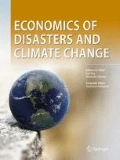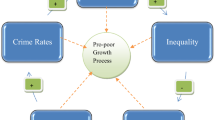Abstract
This paper investigates consequence of 2004 tsunami on income distribution in Sri Lanka, using quantile Difference-in-Difference and Change-in-Change methods, and other inequality measures. The analysis finds that the income of affected households in the entire distribution has recovered, with low-income household’s income increases by a higher proportion as compared to the income increase of higher income households. Similar pattern appears for consumption inconsistently across empirical methods. Nonetheless, the study does not find evidence for increasing inequality associated with long-lasting recovery from the catastrophic tsunami in Sri Lanka.






Similar content being viewed by others
Notes
Recovery is defined in this paper as ability to reduce impact of future disaster. Recovery is measured by the current impact of disaster on wellbeing.
This is a remarkably small decrease in arrivals as compared to the reduced earnings from the tourism sector in the post disaster. The tourist arrivals account for every single visit with at least a single overnight stay in the country. International aid played a major role in the post disaster reconstruction in Sri Lanka and aid agency staff visiting the country after the disaster were most likely included in these counts.
We thank Professor Blaise Melly for generously sharing the CIC STATA codes. Researcher’s work on this method is still in progress.
This pattern of recovery may closely associates to the ending of the internal conflict prevailed in Sri Lanka in 2009 which is well explained in De Alwis and Noy (2019)
References
Albala-Bertrand JM (1993) Natural disaster situations and growth: A macroeconomic model for sudden disaster impacts. World Dev 21(9):1417–1434
Aldrich DP (2010) Separate and unequal: post-tsunami aid distribution in southern India. Soc Sci Q 91(5):1369–1389
Alesch DJ, Holly JN, Mittler E, Nagy R (2001) Organizations at risk: what happens when small businesses and not-for-profits encounter natural disasters? Public Entity Risk Institute, Fairfax
Arnall A, Thomas DSG, Twyman C, Liverman D (2013) Flooding, resettlement, and change in livelihoods: evidence from rural Mozambique. Disasters 37(3):468–488
Athey S, Imbens GW (2006) Identification and inference in nonlinear difference in difference. Econometrica 74(2):431–497
Attanasio O, Székely M (1999) An asset-based approach to the analysis of poverty in Latin America (IDB Working Paper No. 109)
Barrett CB, Marenya PP, McPeak J, Minten B, Murithi F, Oluoch-Kosura W, Place F, Randrianarisoa JC, Rasambainarivo J, Wangila J (2006) Welfare dynamics in rural Kenya and Madagascar. J Dev Stud 42(2):248–277
Becchetti L, Castriota S (2011) Does microfinance work as a recovery tool after disasters? Evidence from the 2004 tsunami. World Dev 39(6):898–912
Boano C (2009) Housing anxiety and multiple geographies in post-tsunami Sri Lanka. Disasters 33(4):762–778
Buia AT, Dungeyb M, Nguyenc CV, Phamb TP (2014) The impact of natural disasters on household income, expenditure, poverty, and inequality: evidence from Vietnam. Appl Econ 46(15):1751–1766
Campano F, Salvatore D (2006) Income distribution. Oxford University Press, Oxford
Carter M R, Barrett C B (2006) The economics of poverty traps and persistent Smoothing and Asset Protection (NBER Working Paper No. 19702)
Cavallo A, Cavallo E, Rigobon R (2014) Prices and supply disruptions during disasters. Rev Income Wealth 60(2):449–471
Chang SE, Falit-Baiamonte A (2002) Disaster vulnerability of businesses in the 2001 Nisqually earthquake. Environ Hazards 4(2/3):59–71
Chernozhukov V, Hansen C (2006) Instrumental quantile regression inference for structural and treatment effect models. J Econ 132(2):491–525
Coast Conservation Department, Revised Coastal Zone Management Plan (2004) Ministry of fisheries and aquatic resources, Colombo, Sri Lanka
Cuaresma JC, Hlouskova J, Michael Obersteiner M (2008) Natural disasters as creative destruction? Evidence from developing countries. Econ Inq 46(2):214–226
Dalhamer JM, Tierney KJ (1998) Rebounding from disruptive events: business recovery following the Northridge earthquake. Sociol Spectr 18:121–141
De Alwis D, Noy I (2019) Sri Lankan households a decade after the Indian ocean tsunami. Rev Dev Econ 2019:1–27
Department of Census and Statistics (2005) Report on impact of tsunami 2004 on Sri Lanka. Retrieved from http://www.statistics.gov.lk/tsunami/census/Summarynew.pdf
Department of Census and Statistics (2016) Sri Lanka poverty indicators: Household income and expenditure survey – 2016, Battaramulla. Retrieved from http://www.statistics.gov.lk/poverty/Poverty%20Indicators_2016.pdf
Food and Agriculture of the United Nations (2015) The impact of natural hazards and disasters on agriculture, food security and nutrition: a call for action to build resilient livelihood. Food and Agriculture organization, Rome
Fussell E (2015) The long-term recovery of New Orleans’ population after hurricane Katrina. Am Behav Sci 59(10):1231–1245
Government of Sri Lanka (2005) Post tsunami recovery and reconstruction strategy - May 2005. Colombo
Government of Sri Lanka (2006) Post tsunami recovery and reconstruction. Joint report of the Government of Sri Lanka and development partners, December 2006. Ministry of Finance, Colombo
Hallegatte S, Dumas P (2009) Can natural disasters have positive consequences? : Investigating the role of embodied technical change. Ecol Econ 68:777–786
Hallegatte S, Vogt-Schilb A (2016) Are losses from natural disasters more than just asset losses? : The role of capital aggregation, sector interactions, and investment behaviors. World Bank policy research working paper no. 7885
Hallegatte S, Bangalore M, Bonzanigo L, Fay M, Narloch U, Rozenbuerg J, VogtSchilb A (2014) Climate change and poverty: An analytical framework (Policy research working paper 7126). World Bank, Washington, DC
Haraguchi M, Lall U (2015) Flood risks and impacts: a case study of Thailand’s floods in 2011 and research questions for supply chain decision making. Int J Disast Risk Re 14:256–272
International Monitory Fund (2018) IMF data mapper. Retrieved from http://www.imf.org/external/datamapper/PPPPC@WEO/OEMDC/ADVEC/WEOWORLD/LKA
Jaramillo C (2009) Do natural disasters have Long-term effects on growth? (Universidad de los Andes Department of Economics Research Paper Series)
Jayasuriya S, McCawley P (2010) The Asian tsunami: aid and reconstruction after tsunami. Edward Elgar Publishing, Cheltenham
Kammerbauera M, Wamslerb C (2017) Social inequality and marginalization in post-disaster recovery: challenging the consensus? Int J Disast Risk Re 24:411–418
Karim A, Noy I (2016) Poverty and natural disasters-a qualitative survey of the empirical literature. Singap Econ Rev 61(1)
Kazianga H, Udry C (2006) Consumption smoothing? Livestock, insurance and drought in rural Burkina Faso. J Dev Econ 79(2):413–446
Khasalamwa S (2009) Is build back better response to vulnerability? Analysis of the post tsunami humanitarian interventions in Sri Lanka. Norwegian J Geogr 63(1):73–88
Kim CK (2010) The effect of natural disasters on long run economic growth. University of Michigan, Ann Arbor
Koenker R, Bassett G (1978) Regression quantiles. Econometrica 46:33–50
Lam NSN, Pace KR, Campanella J, LeSage, Arenas H (2009) Business return in New Orleans: decision making amid post-Katrina uncertainty. PLoS One 4(8)
Landry CE, Bin O, Hindsley P, Whitehead J, Wilson K (2007) Going home: evacuation-migration decisions of hurricane Katrina survivors. South Econ J 74(2):326–343
Madden JF (2000) Changes in income inequality within U.S. metropolitan areas. W.E. Upjohn Institute for Employment, Kalamazoo
Melly B, Santangelo G (2015) The changes-in-changes model with covariates (Working Paper)
Ministry of Environment (2009) Sri Lanka strategy for sustainable development. Ministry of Environment, Colombo
Ministry of Finance and Planning (MoF) (2005) Post tsunami recovery and reconstruction: joint report of government of Sri Lanka and development partners
Muñoz CE, Tate E (2016) Unequal recovery? Federal resource distribution after a Midwest flood disaster. Int J Environ Res Public Health 13(5). pii: E507. https://doi.org/10.3390/ijerph13050507
Parente PMDC, Santos-Silva JMC (2016) Quantile regression with clustered data. J Econom Method 5(1):1–15
Parker M (2018) How global is ‘global inflation’? J Macroecon forthcoming
Powell D (2017) Quantile treatment effects in the presence of covariates (RAND Labor and Population Working Paper)
Rodriguez-Oreggia E, De la Fuente A, De la Torre R, Moreno HA (2013) The impact of natural disasters on human development and poverty at the municipal level in Mexico. J Dev Stud 49(3):442–455
Shaughnessy TM, White ML, Brendler MD (2010) The income distribution effect of natural disasters: an analysis of hurricane Katrina. The Journal of Regional Analysis and Policy 40(1):84–95
Skidmore M, Toya H (2002) Do natural disasters promote growth? Econ Inq 40(4):664–687
Swedish International Development Agency (2009) Long term perspectives on the response to the Indian Ocean tsunami 2004: A joint follow up evaluation of the links between relief, rehabilitation, and development. (Article No. SIDA52010en)
Tierney KJ (1997) Business impacts of the Northridge earthquake. J Conting Crisis Manag 5(2):87–97
The Reconstruction and Development Agency (RADA) (2006) Mid year review, Government of Sri Lanka
Webb GR, Tierney KJ, Dahlhamer JM (2000) Businesses and disasters: empirical patterns and unanswered questions. Nat Hazards Rev 1(2):83–90
Webb GR, Tierney KJ, Dahlhamer JM (2002) Predicting long-term business recovery from disaster: a comparison of the Loma Prieta earthquake and hurricane Andrew. Environ Hazards 4:45–58
Yamamura E (2015) The impact of natural disasters on income inequality: analysis using panel data during the period 1970 to 2004. Int Econ J 29(3):359–374
Acknowledgements
I thank Ilan Noy and Harold Cuffe for their assistance and comments, and Blaise Melly for sharing their stata codes of CIC analysis.
Author information
Authors and Affiliations
Corresponding author
Additional information
Publisher’s Note
Springer Nature remains neutral with regard to jurisdictional claims in published maps and institutional affiliations.
Appendix
Appendix
Tsunami affected districts in Sri Lanka. Source: Department of Census and Statistics (2005)
Rights and permissions
About this article
Cite this article
De Alwis, D. Distributional Impacts of Disaster Recovery: Sri Lankan Households a Decade after the 2004 Indian Ocean Tsunami. EconDisCliCha 4, 195–222 (2020). https://doi.org/10.1007/s41885-020-00058-z
Received:
Accepted:
Published:
Issue Date:
DOI: https://doi.org/10.1007/s41885-020-00058-z















